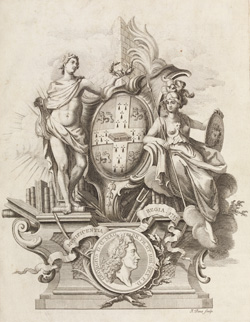Great Industry, Accurate Judgement and Royal Favour: John Moore

John Pine’s engraved bookplate for the Royal Library, 1737, from Moore’s copy of Juan Eusebio Nieremberg, De origine sacræ scripturæ libri duodecim, Lyon, 1641. E.2.32.
John Moore (1646–1714), an undergraduate of Clare College and later Bishop of Norwich (1691–1707) and Ely (1707–1714), was one of the greatest bibliophiles of his day, celebrated for his collection of early English ‘black letter’ printing. The range of manuscripts and early printed books he acquired reflected the breadth of his interests, above all in medicine.
After he died, on 31 July 1714 (one day before Queen Anne), the collection was bought by King George I at Lord Townshend’s suggestion and presented to the University as a reward for Cambridge’s loyalty to the Hanoverian succession during the Jacobite rebellion of 1715. It was known henceforth as the Royal Library. The manuscripts include such treasures as the Moore Bede and the Book of Cerne, and number among them some of the most valuable items in the Library. Yet in many cases comparatively little is known about their origins and provenances: the Library’s greatest accession of all remains in large part mysterious.

Bishop John Moore, a copy by Isaac Whood, c. 1736, of the 1705 portrait by Godfrey Kneller at Clare College.











